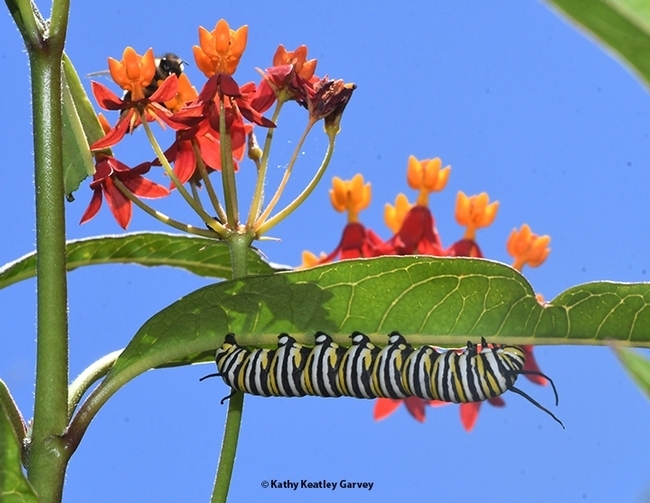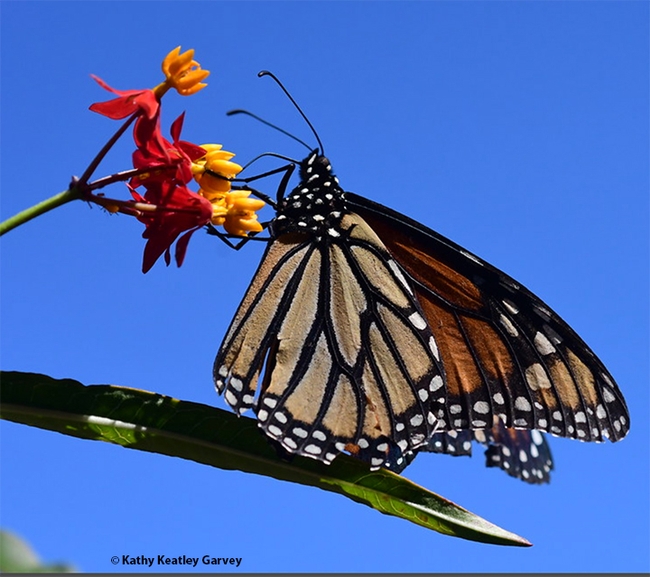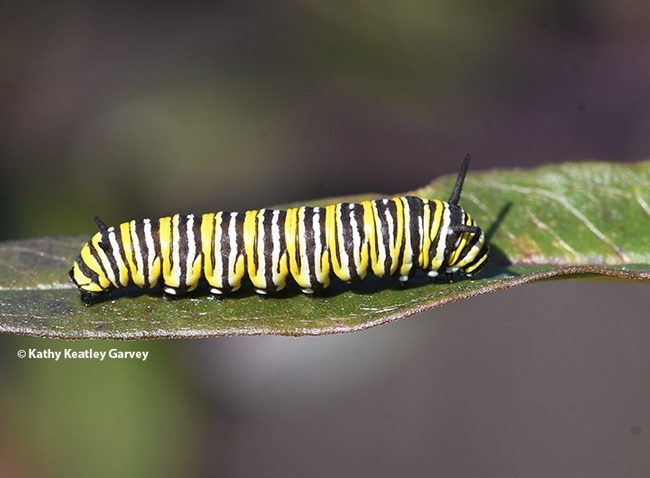David James, WSU entomologist
"The population, counted by citizen scientists at monarch overwintering locations in southern California, dropped from around 300,000 three years ago to just 1,914 in 2020, leading to an increasing fear of extinction. However, last winter large populations of monarchs were found breeding in the San Francisco and Los Angeles areas. Prior to last winter, it was unusual to find winter breeding by monarchs in those locations."
So begins a news release, "New Monarch Butterfly Breeding Pattern Inspires Hope," posted on EurekAlert by the communications specialists at Washington State University, Pullman, Wash., in citing the peer-reviewed research of WSU entomologist/associate professor David James. He's been studying monarchs for 43 years and spearheads a migratory monarch tagging program in the Pacific Northwest.
The WSU news release quotes the monarch scientist: "There's more to it than just counting overwintering butterflies. It seems that monarchs are evolving or adapting, likely to the changing climate, by changing their breeding patterns."
The impetus for the news release? James recently authored "Western North American Monarchs, Spiraling into Oblivion or Adapting to a Changing Environment?" in the journal Animal Migration. He called attention to the huge declines of monarchs--and their resiliency--in Australia when he was working on his PhD dissertation there 40 years ago.
James says that climate-wise, San Francisco is very similar to the area around Sydney. And he thinks that monarchs will adapt well to the changing climate in the western United States, just as the monarchs in the Sydney area have.
The WSU entomologist is now connecting with citizen scientists in California to collect more data on winter breeding that "can show this evolution and adaptability." His research includes data on what milkweed species the monarchs frequent. They include tropical milkweed, Asclepias curassavica, which has thrived in California for more than 100 years. Some advocate a "no grow" policy, declaring that A. curassavica impedes migration and carries more of the Ophryocystis elektroscirrha (OE) spores than the native milkweeds because it can survive the winter in many areas of California, while native milkweed species usually go dormant. Others argue that tropical milkweed is not the cause of the declining milkweed population--that habitat loss and pesticides are. "Just cut it back before the fall migration or cut it back when monarchs are no longer laying eggs" to limit the transfer of OE, they say. Still others insist on planting a variety of milkweed species, including tropical, to give monarchs a choice, that "monarchs know what they want."
A monarch caterpillar and a honey bee sharing a tropical milkweed in Vacaville, Calif. in the summer of 2020. (Photo by Kathy Keatley Garvey)
When we contacted the WSU entomologist earlier this week, he pointed out that "the milkweeds that monarchs were using during winter last year in Santa Clara County were not solely tropical. There are good numbers of Gomphocarpus physocarpus and Gomphocarpus fruticosus being used as well, although these two species are difficult to tell apart."
"I guess the saddest thing that was reported to me last winter was the aftermath of well-intentioned people following 'the rules' to cut down tropical milkweed. My co-authors would find numerous caterpillars and eggs in compost piles and stalks of cut milkweed adorned with dozens of eggs. In both situations, there would be no successful outcome for these immature monarchs. How is that better than leaving tropical milkweed to host and nurture caterpillars?"
"Sure, OE has a negative impact on monarch productivity but so do wasps and other natural enemies. The ultimate negative impact is starvation, of course, which is what happens when you remove tropical milkweed amid reproductive female monarchs."
"The other salient point that keeps coming to mind," James told us, "is that tropical milkweed was very likely the ancestral host of monarchs in the sub-tropics before they evolved their migratory behavior. They may have even evolved migratory behavior as a response to OE! The point is, though, that monarchs can survive with OE but they cant survive without food!"
The good news is that monarchs are increasing in numbers this year at the overwintering sites along coastal California. According to the
Western Monarch Count: On Oct. 16, 2021, volunteers counted than 1300 monarchs at the Pacific Grove overwintering sites, as compared to none last year. Pismo State Beach Monarch Butterfly Grove and an adjacent site tallied approximately 8,000 monarchs on Oct. 20, 2021; last year, these sites hosted less than 300.
James believes that monarchs will NOT go extinct, but "something is happening" and "we need to do more work to find out exactly what is happening."
James' concluding statement in Animal Migration: "Four decades after confirming the existence, and studying the biology of breeding and non-breeding winter monarch populations in Australia, I feel a strong sense of déjà vu. Time will tell, if western U.S. monarch populations are evolving a comparable overwintering ecology in California, but I do know one thing. The high adaptability of monarchs ensures that the monarch butterfly will persist in Western North America. The real question is: How will future populations compare to historical populations?"







Managing OE (Ophryocystis elektroscirrha) on Native and Non-Native Milkweeds
Remember, all milkweeds collect OE (Ophryocystis elektroscirrha) spores. Plants don't make their own OE spores. Monarch adults visiting the plants drop the spores on to the plants. OE is more prevalent in the fall. There are evergreen milkweeds in southern states in late fall and winter that also collect OE spores. Please don't bash tropical milkweeds. It is a native to Mexico and Central Mexico, where it is used year round. Tropical is also used by migrating Monarchs in the spring and fall. Monarchs migrating through Mexico in the spring and fall lay eggs on tropical milkweeds. I wonder if their offspring continue the journey north.
"Tropical Milkweed and the injurious effects of well-meaning people" by Jeffrey Glassberg, President of the North American Butterfly Association
http://nababutterfly.com/wordpress/wp-content/uploads/2015/04/Tropical-Milkweed.pdf
Frankly pulling out tropical milkweed when Monarchs need milkweed is absolutely insane. Milkweed can be sprayed with water to wash off OE spores. All milkweeds should be washed prior to feeding to Monarch caterpillars. Tropical milkweeds don't have hairy leaves to catch and hold spores. Or you can cut it back and allow it to regrow. Cutting back is best done by only cutting back one third of your plants at one time that way you will still have milkweed available when Monarchs need it. Do not cut back milkweed, if there are eggs or caterpillars present because this will deprive them of food. Once cut back cover with garden cloth (Information on using Light Weight Garden Fabric https://www.gardeners.com/how-to/row-covers/5111.html to allow it to regrow.) If left uncovered, Monarchs will still visit and lay on stem of milkweed.
Cutting back tropical is not recommended in south Florida where there are residential non-migratory monarch populations. See information on the south Florida group about not cutting back tropical south of Orlando: https://nickiebodv.blogspot.com/2015/03/welcome.html
Cutting back tropical milkweed in late fall to winter in some areas gets rid of any OE spores and promotes new clean growth. It isn't the plant causing the OE, it is the butterflies that have the OE dropping the spores on the plants. Those OE spores can also drop on nectar and other milkweed host plants. Research has shown that Monarchs that eat tropical are more resistant to OE.
"Patterns of Host-Parasite Adaptation in Three Populations of Monarch Butterflies Infected with a Naturally Occurring Protozoan Disease: Virulence, Resistance, and Tolerance" http://www.jstor.org/stable/10.1086/673442#mobileBookmark
It has also been shown that parents eating tropical gain a resistance to OE and their offspring are even more resistant. Monarchs that eat tropical also produce less tachinid flies. And, are more noxious to predators due to the higher level of toxins in tropical milkweed.
"Trans?generational parasite protection associated with paternal diet"
https://besjournals.onlinelibrary.wiley.com/doi/full/10.1111/1365-2656.12289
Plant natives, but don't give tropical milkweed a bad rap. I find that tropical and african milkweeds are very medicinal for Monarchs. They actually prefer them. If given a choice between natives and tropicals, Monarchs usually choose the more toxic tropical varieties. They will usually lay on swamp over common. Swamp is more toxic. They will usually choose common over butterfly weed. Common is more toxic. “How butterflies self-medicate” https://www.ted.com/talks/jaap_de_roode_how_butterflies_self_medicate/transcript?language=en#t-17545
First identified in the 1960s, this is the first research that was published on
“Ophryocystis elektroscirrha sp. n., a Neogregarine Pathogen of the Monarch Butterfly Danaus plexippus (L.) and the Florida Queen Butterfly D. gilippus berenice Cramer”
R. E. McLAUGHLIN and JUDITH MYERS
https://www.researchgate.net/profile/Judith-Myers-3/publication/229980142_Ophryocystis_elektroscirrha_sp_n_a_Neogregarine_Pathogen_of_the_Monarch_Butterfly_Danaus_plexippus_L_and_the_Florida_Queen_Butterfly_D_gilippus_berenice_Cramer1/links/5f99e497299bf1b53e4ed39e/Ophryocystis-elektroscirrha-sp-n-a-Neogregarine-Pathogen-of-the-Monarch-Butterfly-Danaus-plexippus-L-and-the-Florida-Queen-Butterfly-D-gilippus-berenice-Cramer1.pdf?origin=publication_detail
“Host Diet Affects the Morphology of Monarch Butterfly Parasites”
Kevin Hoang, Leiling Tao, Mark D. Hunter, Jacobus C. de Roode” Abstract
Understanding host–parasite interactions is essential for ecological research, wildlife conservation, and health management. While most studies focus on numerical traits of parasite groups, such as changes in parasite load, less focus is placed on the traits of individual parasites such as parasite size and shape (parasite morphology). Parasite morphology has significant effects on parasite fitness such as initial colonization of hosts, avoidance of host immune defenses, and the availability of resources for parasite replication. As such, understanding factors that affect parasite morphology is important in predicting the consequences of host–parasite interactions. Here, we studied how host diet affected the spore morphology of a protozoan parasite (Ophryocystis elektroscirrha), a specialist parasite of the monarch butterfly (Danaus plexippus). We found that different host plant species (milkweeds; Asclepias spp.) significantly affected parasite spore size. Previous studies have found that cardenolides, secondary chemicals in host plants of monarchs, can reduce parasite loads and increase the lifespan of infected butterflies. Adding to this benefit of high cardenolide milkweeds, we found that infected monarchs reared on milkweeds of higher cardenolide concentrations yielded smaller parasites, a potentially hidden characteristic of cardenolides that may have important implications for monarch–parasite interactions.” https://bioone.org/journals/journal-of-parasitology/volume-103/issue-3/16-142/Host-Diet-Affects-the-Morphology-of-Monarch-Butterfly-Parasites/10.1645/16-142.full
I don’t know why, but I have found African Milkweed, Asclepias physocarpa to be very medicinal. I did a little experiment to prove this. I introduced sickly caterpillars to the plant. I kept them enclosed in organza bags outside as they grew and completed their cycle. Monarch caterpillars that weren't thriving were able to grow successfully and pupate after they were introduced to the african milkweed, Asclepias physocarpa. This post has the details.
https://www.facebook.com/mona.miller.73/posts/10216149671373840
“Milkweeds, monarch butterflies and the ecological significance of cardenolides”
Stephen B. Malcolm https://www.researchgate.net/profile/Stephen-Malcolm/publication/226101016_Milkweeds_monarch_butterflies_and_the_ecological_significance_of_cardenolides/links/5b9ff04645851574f7d25661/Milkweeds-monarch-butterflies-and-the-ecological-significance-of-cardenolides.pdf?origin=publication_detail (scroll down to read on this link). I did find in this article that tropical milkweed, Asclepias curassavica has the highest level of toxins.